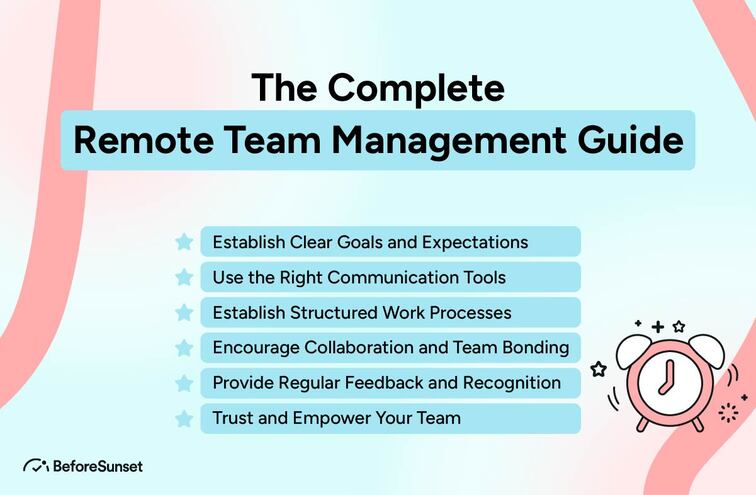In today's fast-paced environment, when teams are increasingly dispersed across many places, remote team management is an essential ability.
It's essential to comprehend the advantages and difficulties of managing a remote team.
In this blog post, we'll look at the benefits of managing a remote team, talk about potential difficulties, and provide you vital tips for running a remote team effectively.
You can boost productivity, encourage cooperation, and succeed in remote team management by taking these actions and putting the proper methods into practice.
What are the Benefits of Managing a Remote Team?
1. Reduced Cost
Managing a remote workforce saves a lot of money because there is no longer a requirement for an actual office. Rent, utilities, and office supply costs are decreased.
2. Increased Efficiency
Team members can work remotely in their preferred settings, which boosts productivity and efficiency. Employees' workspaces can be tailored to their needs, improving focus and minimizing distractions.
3. Improved Productivity
Flexibility is encouraged by remote team management, enabling team members to work when they are most productive. It ends the time lost in commuting, allowing people to devote more time to their duties and obligations.
4. Improved Team Collaboration
Remote team management encourages collaboration through a variety of communication and collaboration technologies despite physical distance. Project management software, file sharing websites, and virtual meetings make it easy to collaborate and share expertise.
5. Increased Productivity
A results-oriented mindset is encouraged when managing a remote staff. The emphasis switches from just focusing on hours spent to accomplishing outcomes and exceeding objectives. This encourages a sense of accountability and ownership among team members.
6. Enhanced Focus on Results
In order to manage a remote workforce effectively, communication must be effective. Real-time interactions are made possible by virtual communication tools like video conferencing and instant messaging platforms, ensuring that team members are kept informed and engaged.
8. Enhanced Morale
Higher employee morale is a result of the enhanced flexibility, autonomy, and work-life balance that remote work affords. The option to work from any location is valued by the team, and this optimistic outlook helps to create a motivated and engaged staff.
9. Increased Work-Life Balance
Team members can better balance their personal and professional life with remote team management. It gives you the freedom to fulfill personal obligations, spend time with your family, and engage in hobbies, which enhances your well-being and job satisfaction.
10. Increased Agility
Organizations can easily adjust to shifting conditions by managing a remote crew. Working remotely gives you the freedom to scale teams up or down as necessary, access a global talent pool, and more quickly adapt to market demands.
What are the Challenges of Managing a Remote Team?
1. Lack of face-to-face contact
The development of interpersonal relationships and trust among team members can be difficult when there are no physical encounters. Missing nonverbal cues could result in misconceptions or poor communication.
2. Difficulties in communication
In a remote team environment, effective communication becomes even more crucial. The use of digital communication technologies, time zone differences, and language limitations can all present difficulties and obstruct effective communication.
3. Difficulty in managing a distributed team
Coordination and planning are necessary for leading a team that is dispersed across several places. Aligning schedules, addressing time zone variances, and ensuring dependable collaboration can be difficult.
4. Difficulty in ensuring productivity
It might be difficult to keep team members on task and productive without direct supervision. Clear expectations must be made, goals must be established, and procedures must be put in place to track development.
5. Lack of clarity in team goals
Understanding the larger organizational goals and their individual roles in attaining them may be challenging for remote teams.
6. Lack of effective team-building strategies
It might be difficult to foster a sense of unity and belonging among a remote workforce. To promote a strong team culture, it is necessary to modify traditional team-building exercises for virtual environments.
7. Difficulty in ensuring team accountability
It may be difficult to ensure accountability without direct supervision. Transparent performance metrics must be established, regular feedback must be given, and an accountable culture must be promoted.
8. Lack of effective project management practices
To plan activities, monitor progress, and make sure deadlines are fulfilled by remote teams, a lot of project management tools are used. To keep projects moving forward, managers must employ efficient project management techniques.
9. Challenge in ensuring that tools and resources are available
It can sometimes be difficult to provide access to the appropriate tools and resources in a distant situation. Managers must make sure that team members have the tools, resources, and assistance they need to complete their work effectively.
10. Lack of clarity in company culture
When team members are spread out across several locations, it can be challenging to maintain a strong business culture and shared values. The company's culture should be regularly communicated and reinforced.
How to Manage a Remote Team Effectively?
Step 1: Determine Your Responsibilities
Be sure to specify your role and responsibilities as a remote team manager. Create a plan to accomplish the important activities you need to complete.
Step 2: Educate yourself on the struggles of remote management
Recognize the particular difficulties involved in leading a remote team. Keep current with industry developments, best practices, and efficient remote management techniques.
Step 3: Figure out and delegate responsibilities
Find out who on your team has what skills and strengths. To enable team members to effectively contribute, assign assignments based on their unique skills and interests.
Step 4: Make precise standards for remote work productivity
For your team, develop performance measures and set forth clear expectations. Establish productivity criteria and share them with everyone to guarantee accountability.
Step 5: Bring in right remote work tools
Utilize technologies and solutions for remote work that improve productivity, teamwork, and communication. Our productivity solution, BeforeSunset AI, provides a whole set of capabilities made exclusively for managing remote teams.
Step 6: Give team members the chance to input ideas
By giving team members the chance to contribute their thoughts, recommendations, and feedback, promote active engagement and collaboration. Encourage an innovative and inclusive culture.
Step 7: Clarify the rules, determine outputs, forget about activity
Instead than micromanaging tasks, concentrate on the results and outcomes. Expectations, due dates, and deliverables should be made clear to encourage team members to take responsibility for their job.
Step 8: Gather feedback regularly
Take input from your team members on a regular basis to better understand their wants, difficulties, and ideas. Utilize this input to strengthen team dynamics, address issues, and improve processes.
Step 9: Provide emotional support
Recognize that working remotely can occasionally be isolating. Provide emotional support and show empathy for the special situations and difficulties that your team members might be facing.
Step 10: Don't neglect one-on-ones
Set up routine one-on-one meetings with each team member to go over their progress, offer direction, handle any issues, and foster better communication.
Step 11: Be flexible
Flexibility in working hours and scheduling is possible with remote employment. Allow team members to strike a healthy work-life balance by accommodating individual preferences and responsibilities.
Step 12: Get the team together physically once in a while
While remote work is the norm, planning sporadic in-person meetings or retreats to promote deeper relationships, cooperation, and team building may be a good idea.
Step 13 : Include physical meetings sometimes
When possible, hold face-to-face meetings to strengthen team relationships, promote communication, and foster trust.
Step 14 : Treat all employees equally
Make sure that your remote team is equitable and fair. Regardless of geography or background, offer equal opportunities for development, progress, and recognition.
Step 15 : Be aware of overworking and overloading team members
The distinction between personal and professional life might become hazy when working remotely. By supporting self-care and appropriate limits, you can keep an eye on workloads, promote work-life balance, and avoid burnout.
Step 16 : Create a virtual water cooler
Encourage casual encounters and develop online communities where team members can get together, exchange interests outside of work, and socialize.
Step 17 : Provide continuous feedback
Give your team members ongoing feedback that emphasizes their strengths, discusses their areas for improvement, and acknowledges their accomplishments. Regular feedback encourages development and improvement.
Bonus Step 18 : Recognize excellence when it happens
Recognize and value remarkable efforts and accomplishments. Celebrate significant occasions, honor individual and group achievements, and foster a culture of appreciation.
FAQ
What Tools and Technologies are Used to Manage Remote Teams?
Communication systems like Slack and Microsoft Teams, project management tools like Asana or Trello, video conferencing platforms like Zoom, and cloud storage platforms like Google Drive or Dropbox are just a few examples of the tools and technology that can make managing remote teams easier.
With the advancements in technology, innovative solutions like BeforeSunset AI are emerging to revolutionize remote team management.
In addition to the existing individual version, we are planning to release a team version where team members can work in sync with each other!
How Do You Ensure Team Productivity When Working Remotely?
Establish clear objectives and expectations, offer the required tools and resources, communicate well, keep track of progress using project management tools, and promote open and honest communication among team members to ensure team productivity in a remote context.
Regular check-ins and feedback sessions can also support accountability and focus.


